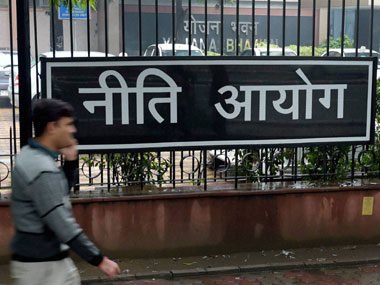Planning Commission was set up in India through a Cabinet resolution dated the 15th March, 1950. It became a part of the Government of India in 1961 when it was assigned a specific role and responsibilities under the Allocation of Business Rules, 1961 by making Entry 26 related to the Ministry of Planning and Entry 49 related to the Planning Commission. The key functions assigned to the Planning Commission included plan formulation, assessment and allocation of plan resources to the central ministries and the States and union territories, identification of constraints, appraisal and corrections, programmes for area development, etc.
The touchstones for the performance of the Planning Commission in the overall perspective of national development should be:
- Did it achieve the goals of development and simultaneously furthered equity?
- Did it work towards strengthening fiscal federalism and consequently federalism per se?
- Did it become a platform for corrections for post-Finance Commission fiscal inaccuracies or aberrations resulting from factors beyond the control or perspectives of the successive Finance Commissions?
- Did it perform the role of the platform for corrections in the mid course context of five year plans, their targets and programmes or schemes?
With regard to the achievement of the goals of development and furthering equity, the track record of Planning Commission should be viewed for three distinct periods of its existence. The period from 1950 to 1980 typically characterised the era of “Hindu rate of growth” in which the real incomes grew around 1 per cent per annum. The period from 1980 to 1990 was the period of marginal revival of growth. Even in this decade, the higher growth rates could also be partly attributed to the salary revisions of the central and state government employees. The post 1990 era witnessed an upswing in the growth rates for the economy but the credit could not be placed on the planning process because the reform era began before the 1992-97 five year plan was finalised. The overall assessment of the performance of planning process towards achieving the macro objectives set out in the successive five year plans could at best be rated as “AVERAGE”.
In terms of the role and performance of the Planning Commission in regard to strengthening fiscal federalism and furthering equity, one needs to look at the instrumentalities of fiscal federalism in India. Finance Commissions constituted under the provisions of Article 280 of the Constitution of India from time to time are, by implication, constitutional bodies and have their task cut out in accordance with the provisions of the said article. When one looks at the history of the recommendations of the Finance Commissions, it becomes amply clear that fiscally weaker States have been taken care of through the mechanism of the Revenue Deficit Grants when the own tax and non-tax revenues and the share in central taxes put together can not fulfil the commitments of the revenue expenditure. On the other aspect, the vertical devolution to the States in the design of tax sharing has been progressive and has reached about a one third of the aggregate central taxes being devolved to the States. In this manner, the Finance Commissions can be judged to have furthered equity and also strengthened the concept of fiscal federalism towards greater harmony between the Centre and the States.
Although the Planning Commission was not a constitutional body, yet it had an important role to play in meeting the challenges of fiscal harmony between the Centre and the States as also furthering equity in the overall design. It met the first objective of attaining higher level of harmony between the Centre and the States as it afforded to rectify any aberrations which could not be attended to through the reports of the successive Finance Commissions when it assessed the financial resources of the States on an annual basis through the exercise of determining the resources available for plan financing. On this count, the Planning Commission acted as a platform for the States to voice their financial problems and also redress the same to a certain extent within the limitations of the overall parameters within which it had to operate. A good example of this phenomenon was setting up of the Rangarajan Committee to look into the problems resulting from the recommendations of the Ninth Finance Commission in the context of special category hill States. In terms of accommodating the changing political and economic scenario, the changes in the design of central plan assistance allocation from time to time had been progressive and also simultaneously giving space to the demands of the States. The change from Gadgil formula to Gadgil-Mukherjee formula at the NDC meeting in the early 1990’s clearly established that the Planning Commission achieved a certain degree of harmony between the Centre and the States. Since in a typical federal structure, there has to be a certain element of give and take, all constituents of the federation can not be in a state of equal happiness but the instrumentalities should achieve an overall larger measure of harmony. In that context, the Planning Commission certainly achieved the objective of strengthening the federal structure as also the fiscal federalism.
As to the question of enhancing equity through the process of resource allocation for plan financing, the track record of the Planning Commission could be considered praiseworthy. The instrument of Gadgil Formula till 1990 and the Gadgil-Mukherjee dispensation post 1990 ensured a fairly high equity in the two-stage scheme of allocation of central assistance for plan financing. In the first stage, it classified the States into two groups – namely the special category States and the other or non-special category States. For the former, the determination of plan size was not a function of the State’s own resources but that of the assessed and felt developmental needs of these States. For the other States, the plan size was more a function of the State’s own resources as the central assistance for plan financing was fixed through the Gadgil formula or its successor formula. In the second stage for enhancing equity, keeping in view the poor fiscal capacity of the special category States, the central assistance for plan financing was dispensed on the basis of 90 per cent grant and 10 per cent loan basis. For the non-special category States, the dispensation was on the basis of 30 per cent grant and 70 per cent loan basis. It also ensured preferential central assistance funding of the special area programmes. Based on the experience, one could say that the Planning Commission acquitted itself in an excellent manner in the context of strengthening fiscal federalism and enhancing equity.
In regard to the role of Planning Commission to act as a platform for corrections post-finance commission fiscal inaccuracies and aberrations resulting from factors beyond the control or perspective of the Finance Commissions, the author has been witness to several meetings between the Deputy Chairman, Planning Commission, and the Chief Minister of the State. These meetings have certainly addressed the post-Finance Commission financial problems and resolved the crisis situations to the advantage of the fiscally poor States.
On the question of mid-course corrections in the programmes for a five year plan, the Planning Commission has been attempting the mid-term appraisal of the five year plans from time to time. The practical utility of such exercises has not been of notable magnitude. The mid term appraisal documents do make a good reading but were found wanting in their relevance to the State Plans. On this count, the performance of Planning Commission has been far from satisfactory.
With this brief commentary on the historical scenario about the utility and performance of the Planning Commission, we reach the present. The decision to scrap the Planning Commission by repealing the Cabinet Resolution of 15th March, 1950 was taken in the meeting of the Union Council of Ministers held on the 13th August, 2014. The Prime Minister announced from the ramparts of Red Fort on 15th August, 2014 his intent to replace the Planning Commission with a “New Institution”. The era of socialistic planning model had thus come to an end on the 13th August, 2014.

- What will be the fate of plan formulation process for Five Year and Annual Plans at the Centre and the States?
- How will the financial relations between the Centre and States be addressed?
- What will be the Monitoring, review and appraisal mechanisms?
- How will the social security schemes be taken care of under the new dispensation?
With regard to the question of five year plans, the emerging scenario or the early prognosis indicates to sudden demise of the process of framing Five Year or Annual Plans. The Twelfth Five year Plan is more than half over. The coming year would have been the fourth year of the five year plan. There has been no formal annual plan finalisation drill for two years on now. Given the current impasse, one could make a conjecture that the era of five year plans is over. We are in a sort of state of “Plan Holiday” at present without acknowledging this reality.
The proposed new dispensation of NITI Aayog appears to be a clear step forward towards “Market led economy”. Market is good for promoting competition and growth but it does not protect the uncompetitive and under-privileged – be it individuals or regions. For ensuring this, appropriate insulation mechanisms shall have to be put into place immediately as abrupt shift to market led economy can be very harsh to the uncompetitive and under-privileged – be it individuals or regions.
The role envisaged for the new institution appears to have the following tasks:-
-Evolve consensus on National Development strategy,
-Foster cooperative federalism,
-Define reforms agenda,
– Act as a platform for resolution of cross sectoral issues in the centre and the States,
– Act as the knowledge and innovation hub, and
– Act as a capacity building and technology watch group.
The details on the above formulation will probably be defined in finer text in the notification of the Cabinet Resolution and will need to be further studied to understand and appreciate the direction in which we are headed or will it be a replication of the role which had been assigned to the Planning Commission?
It appears that we are headed in the direction of a medium term or long term national development strategy with appropriate concurrent review mechanisms and on-course correction instrumentalities. One is reminded of the “Rolling Plan Concept” which was experimented in the late 1970’s and early 1980’s. The experiment did not take off then and it appears difficult that such a design will take off!
Coming to the issue of promoting fiscal federalism, it has been made out earlier in this paper that the Planning Commission did achieve a certain measure of success in furthering fiscal federalism and also promoting equity. In the new set up, there is precious little to talk of participatory federalism when one looks at the numbers of financial resource control between the centre and the States. The plan component of the Union budget accounts for only 26 per cent of resource command and the remaining 74 per cent is non-plan. The plan component is further divided into central sector programmes (Central Ministries) commanding 41 per cent of the plan resources. Another 44 per cent of the resources are commanded by the centrally sponsored schemes whereas only 15 per cent of the resources are transferred to the States and Union territories. It is, therefore, this 15 per cent of 26 percent – amounting to 3.9 per cent of the Union budget on which the new structure is going to talk about cooperative federalism. The step forward in this behalf should be to abolish all the centrally sponsored schemes and transfer the resources thus released to the States as block grants. Such a step will enhance the resource command of the States to about 10.5 per cent.
The rumblings about the role of the new institution in regard to allocation of central plan assistance to the States indicate that this function will be performed by the Finance Ministry. What will be the fate of the Gadgil-Mukherjee formula for central plan allocation will be known after the presentation of the budget for 2015-16. If status quo is maintained, will it indicate continuation of the existing scheme or it will become a topic for discussion and debate for ensuring or achieving greater robustness in the scheme which may come in its place!
As regards independent review, monitoring, appraisal and evaluation mechanisms, there exists a whole host of organisations like PEO, Ministry of Programme Implementation, Cabinet Secretariat, CSO, NSSO and the State level evaluation outfits besides private agencies specialising in these fields. Therefore, even in the new scenario of NITI Aayog, these should not be a matter of concern. The issue which emerges to be resolved or further debated is the role of Ministry of Planning versus the NITI Aayog and how will the NITI Aayog interface with or use the existing instruments? How will it interface with the Cabinet Secretariat in regard to the role of coordination between various central ministries?
Coming to the issue about the future of the social security schemes, the new design is believed to envisage a greater freedom to the States in determining the policies and programmes within the overall national longer view. Therefore, the issues relating to the basket of social security schemes should not really bother the State governments. The important aspect which needs to be factored into resource allocation for such schemes is that the resource application for these programmes should not be a progression in time series but linked to the nature and magnitude of these problems.
Ultimately one has to take a call on the critical issue of the status of the new body. Since it is not a constitutional authority, how will it gel with the existing constitutional bodies? The Inter States Council and the Zonal Councils have been in existence under the provisions of Constitution of India Article 263. This structure remained nearly dormant till the government decided to use this forum for deliberating upon the report of the Sarkaria Commission and also moving on to a further level in decentralisation as also a large consultative role to the States! Will it tread on the toes of the Inter States Council and the Cabinet Secretariat?
The new design also indicates that it will look at restructuring the flow of central plan assistance to the States. Does it imply that it proposes to rejig the Gadgil-Mukherjee dispensation which has stood the test of time for nearly half a century? How will the interests and concerns of the States in general, and those of the special category States, in particular, be addressed? Is such a role envisaged for the new body at all also needs to be answered in the first place?
The contours of the new institution indicate a strong centralisation. How will the utopia of decentralisation be addressed by the new entity? As mentioned earlier, the transition from Planning Commission to the NITI Aayog has been abrupt. One would have wished a seriously considered and calibrated approach to the change. Abrupt change, at times, can lead to derailment of several processes and disruption of a wide range of parameters of the economy in the absence of a legally and constitutionally backed coordination mechanism and this aspect needs urgent attention.
The new instrumentality will probably have to live with a 1000 strong bureaucracy of the Planning Commission. There has to be a strong element of reorientation and training for these people who are used to a particular style of functioning. They are tools of a well entrenched socialistic planning model and will now be expected to deal with realities of market.
Lastly, the ideology behind the new structure is very largely dependent upon a successful decentralisation. The present status of decentralisation to the third level of governments (namely the Panchayati Raj and Urban local bodies) is a hopeless situation with the reality that the State Governments have actually done precious little to assign and transfer all or some of the functions, functionaries and funds to these bodies as were envisaged in the amendments to the Constitution. If this dream has to be achieved, we will probably be required to create a “District List” to entrust certain activities in a definitive manner to the third level of governments that have come about and been in existence for nearly two decades after the 73rd and 74th Constitutional amendments in the Seventh Schedule (Article 246) to the Constitution on the same lines as for the Union List, State List and Concurrent List
Devinder Kumar Sharma, a former Principal Adviser and Secretary Planning, Government of Himachal Pradesh, is a visiting professor and an economist. He lives in Shimla.





